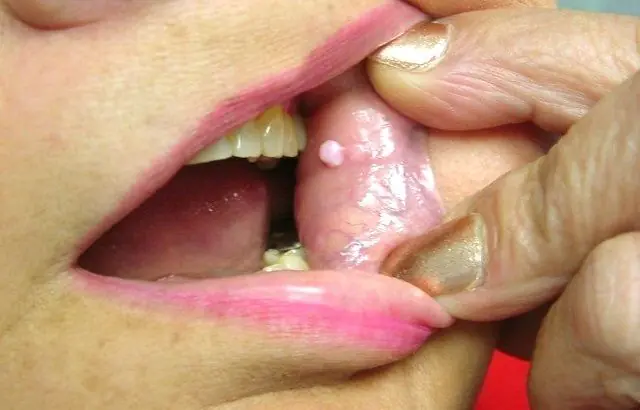
- Reasons for appearance
- What do papillomas look like on the inside of the cheek?
- Treatment options
- Medicines
- ethnoscience
- Surgical removal
Papilloma on the cheek in the mouth is a benign neoplasm that develops from the epithelium due to changes in cell structure. This is the most common type of tumor diagnosed by otolaryngologists. Most often it is detected in women over 40 years of age and in children aged 7-10 years. In most cases, it occurs as a result of exposure to HPV types 6 and 11.
Causes of papilloma on the inside of the cheek
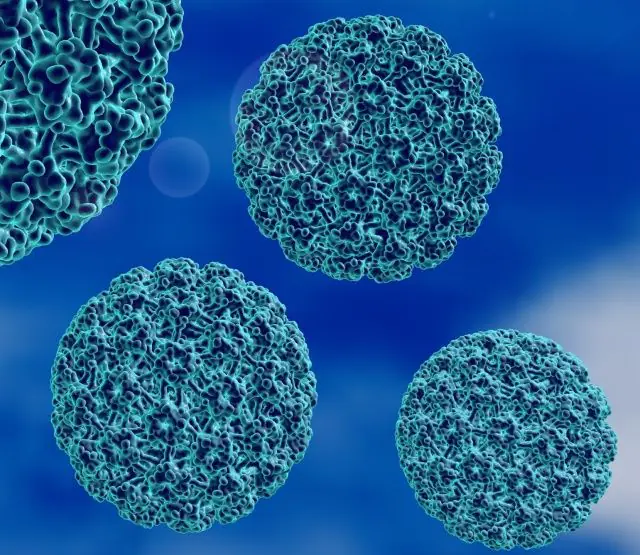
The main reason for the occurrence of such a neoplasm here is the penetration of the papilloma virus into the body. If it gets on the mucous membranes of the oral cavity and does not encounter obstacles on its way, then sooner or later it provokes the appearance of a growth.
Here's what can trigger the process of papilloma formation on the cheek in the mouth:
- Kissing infected people. HPV does not tolerate being outside the human body very well, but during such contacts it gets inside safely. This is especially true if there is a large accumulation of saliva and if there are traces of blood in the oral cavity, where the concentration of the virus is quite high.
- Oral sexual contact. First of all, those whose partners have papillomas on the phallus or on the female genital organs are susceptible to infection with HPV in this way. The virus is located inside these formations and when the oral mucosa comes into contact with the tissues in these places, it easily migrates. In the absence of proper treatment, the process of formation of papilloma on the cheek in the mouth begins.
- Low level of personal hygiene. This applies to those who ignore mouth rinses, which should be used to eliminate bacteria. This also applies to those who do not brush their teeth well enough. Using someone else's brushes that have traces of HPV on the surface can also lead to the appearance of a formation on the cheek. Since it is always contained in the saliva and blood of an infected person, the likelihood of papilloma formation on the inside of the cheek is very high.
- Sharing utensils with the patient. If cups, spoons, forks, knives, plates, pots and other similar household items are not washed well, then the papilloma virus may remain on them. That is why a healthy person who eats food with their help can easily become a carrier of HPV.
Using contaminated objects and kissing sick people does not necessarily cause papillomas to appear on the inside of the cheek. This only happens subject to decreased immunity levels and when its reaction to virus attacks worsens. This, in turn, is caused by a lack of vitamins C, E, A, iron, zinc and a number of other useful substances.
The cause of deterioration of immunity and the formation of papilloma on the buccal mucosa can also be stress, chemotherapy and radiation therapy, long-term treatment with hormones, uncontrolled use of antibiotics, which worsens the intestinal microflora. Poor environment, lack of sleep, colitis, gastritis and other stomach diseases can also increase the likelihood of the formation of such a growth.
After entering the body, this formation does not appear immediately; at first the virus is in a “dormant” state, and under the influence of the factors listed above, it gradually “awakens” and becomes more and more active. The stronger it affects healthy cells, the faster the formation of papilloma on the buccal mucosa.- See also the causes of papillomas on the inside of the lip
What do papillomas look like on the inside of the cheek?
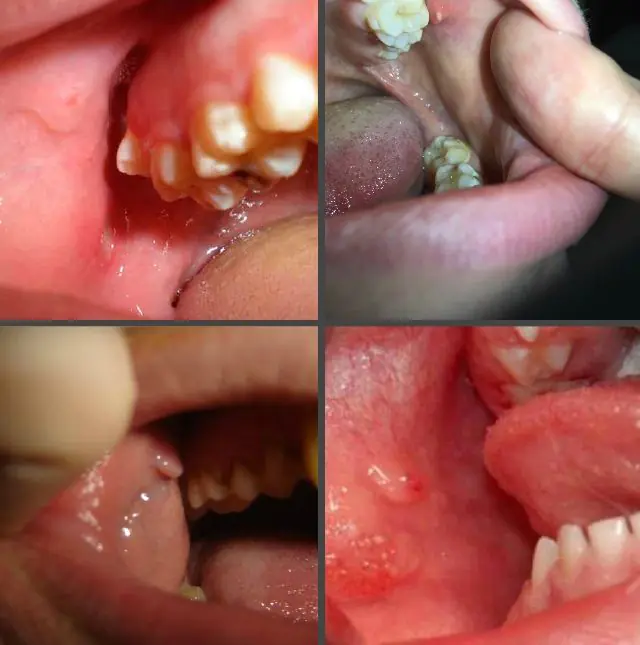
Photo of papillomas on the inside of the cheek
Identifying this formation is not particularly difficult; just a visual examination is sufficient, even without the use of a special medical mirror. It can be performed by either a dentist or an ENT specialist; both of these doctors specialize in the study and treatment of diseases of the mucous membranes of the oral cavity.
At the very beginning, the formations may go unnoticed, since they represent a small bump that does not stand out against the general background and does not cause much discomfort. As they grow, the discomfort also increases. At the same time, in the photo of people with papilloma, small ulcers and ulcers can be seen on the inside of the cheek.
An already formed papilloma can be pointed or flat. In the first case, it is a growth with a rather long stalk, rising above the mucosa by several millimeters. Its diameter can reach 0.7 cm, as a result of which the formation prevents a person from eating food normally, brushing his teeth and other similar procedures.
Peculiarity genital papillomas on the buccal mucosa consists of lightly trampling them. This occurs when teeth, especially fangs, accidentally come into contact with its surface. In such a situation, bleeding may occur, the mucous membrane may become inflamed, and it will sting when exposed to hot, cold, or salty foods.
The surface of pointed papillomas on the buccal mucosa is not smooth; in appearance, they are somewhat reminiscent of a cockscomb or cauliflower. They are covered with numerous papules and small dots. Formations of this type usually appear here in quantities of 2-3 pieces, in rare cases they appear in a single copy. At first there may be few of them, but as the virus progresses, this number increases.
Also on the inside of the cheeks often appear flat papillomas, the size of which is usually smaller than that of pointed ones. They have a pale tint, most often whitish, an uneven surface and unclear boundaries. Their size most often does not exceed 0.5 cm, and these growths are not so noticeable.
During pathological processes, the papilloma can turn black, become rough, and even on its own, for no apparent reason, can partially begin to fall off. This is usually due to the negative impact of traumatic factors on it - hot, spicy, salty, etc.
Important! When papilloma grows on the inside of the cheek and spreads to other areas, the timbre of the voice may change, becoming hoarse and low. This often results in problems with tongue movement and chewing food.- Read also what warts in the mouth look like
Methods for treating papilloma on the inside of the cheek
A papilloma that appears on the cheek in the mouth should alert a person, although it is usually benign. Immediately after its detection, you need to contact an ENT specialist, dentist or therapist for diagnosis and effective treatment. A timely response to this growth will help to avoid malignant processes and prevent you from putting your life in danger.
Treatment of papilloma on the inside of the cheek with medications
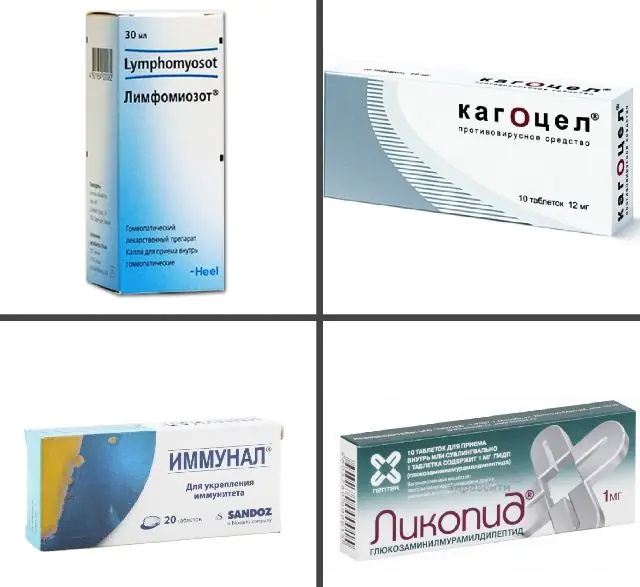
In the photo there are preparations for papillomas on the inside of the cheek
First of all, you need to strengthen your immune system by drinking special immunostimulants. Among them, Immunal, which costs about 250 rubles, best copes with its tasks. (120 UAH). It is sold in liquid form, making it easy to use. It can be replaced by Lymphomyosot, also available in the form of drops. You can also recommend taking Echinacea purpurea, which is the most economical option. Treatment of papilloma on the buccal mucosa should be carried out for at least 2-3 weeks.
In parallel with taking immunostimulants, it is recommended to drink antiviral drugs - Likopid, Kagocel or Cytovir-3. On average, they need to be taken for 5-10 days; taking it longer is not recommended in order to avoid suppression of the intestinal microflora.
It is recommended to use external means Miramistin, which perfectly reduces the activity of bacteria, viruses and infections. They need to rinse their mouth 2-3 times a day for 2-3 minutes. It costs about 200 rubles. (90 UAH).
It has a good analogue - Chlorhexidine. Both are antiseptics, but the latter is recommended to be used 2-3 times a day. Successful treatment of papilloma on the buccal mucosa will take at least a week.
Traditional medicine for papilloma on the inside of the cheek

The most famous remedy is tincture of calendula, which needs to be used to wipe the papilloma 3-5 times a day. To do this, you can use an ear stick or a piece of cotton wool, moistening them in the composition.
It will work well instead sea buckthorn oil, they need to lubricate the formation twice a day for 7-10 days.
You can also rub the cone with peeled garlic, treat it with the juice of celandine and aloe, potatoes and lemon.
In the treatment of papilloma on the buccal mucosa, it also helps tincture of walnuts, prepared with the addition of 50 g of this component along with crushed green shells and using vodka, which is taken 2 times more. All this is mixed and left in a jar for 2 weeks, kept in a dark place. After this time, the composition must be filtered, soak a cotton swab in it and wipe the growth. This must be repeated 3 times a day, treatment is carried out for about 2 weeks.
To combat papilloma on the oral mucosa, it is also widely used. Castor oil, which is recommended to be preheated. They treat formations with an ear stick 2-3 times a day. For this to help, treatment should be carried out for at least 10 days.
It is useful to rinse your mouth soda solution, for the preparation of which you should add this component (2 tsp) to 200 ml of warm water and stir well. This procedure must be carried out 5 times a day for 2-3 minutes.
Lubricating the build-up will be no less useful. propolis, which has bright cleansing and anti-inflammatory properties.
Also, when treating papilloma on the buccal mucosa, you should pay attention to infusion of wormwood and chamomile, of which you need to take 2 tsp per 250 ml of water. The composition must be kept covered for 2-3 hours, filtered and used to rinse the mouth 3-4 times a day. This treatment should be carried out for at least 10 days.
- Read also how to cure papillomas in the mouth with folk remedies
Surgical removal of papilloma on the inside of the cheek
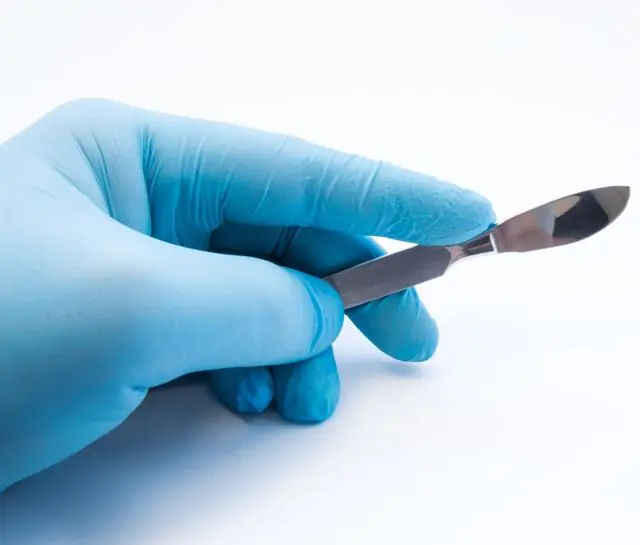
If medications and traditional methods do not give the desired results, all that remains is to consult a surgeon. He can remove the tumor using a scalpel, but this will require local or general anesthesia. With small volumes of intervention, it is quite possible to limit oneself to partial anesthesia.
The disadvantage of surgical removal of papilloma on the buccal mucosa is the high likelihood of bleeding, infection, discomfort and negative consequences in the form of swelling and scars. The operation lasts on average 30 minutes, and the larger the formation, the longer it takes. After this, the patient is left in the hospital for several days to recover.
Laser therapy is not very relevant for removing papilloma on the buccal mucosa; due to its inconvenient location, the beam cannot penetrate there properly and destroy the formation completely. However, when the growth is shallow, this method is sometimes still used. The price of laser therapy is 2900 rubles (1300 hryvnia). The operation lasts about 30 minutes and is performed under local or general anesthesia.
Liquid nitrogen is also rarely used to freeze papilloma on the buccal mucosa. If cryodestruction is carried out, it is very difficult for the doctor to guarantee complete control of the intensity of the effect on the growth. This may require a second and third session, which is disadvantageous and inconvenient for patients, as each session lasts about 20 minutes. The price for removing papilloma with liquid nitrogen is 360 rubles. (150 UAH).
Considering all the shortcomings of cryodestruction and laser therapy, it is not surprising that among physiotherapeutic techniques the most preferable are electrocoagulation and radio wave elimination of papilloma on the inside of the cheek. The second is based on the use of a special knife, which allows you to remove the formation without damaging healthy tissue, and the first involves the impact of an electric current on the growth, cauterizing it. The price of electrocoagulation is 590 rubles (250 hryvnia), and radiosurgical removal is 3,000 rubles (1,200 hryvnia).
Before removing papilloma on the cheek in the mouth, regardless of the technique used, the doctor must take a sample and send it for histological examination to prevent malignancy of the process. The operation can be performed only after obtaining a negative result; sometimes after such an intervention an additional biopsy is required.
- Related article: Visiting an otolaryngologist for oral papilloma



